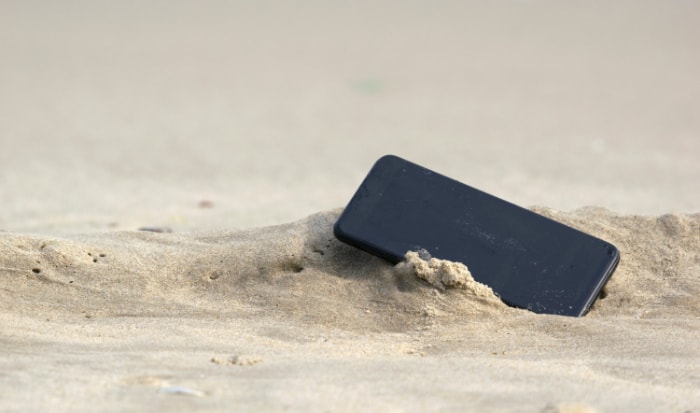How to Get Sand Out of Charging Port: Easy Steps

Electronics and sand: two elements that don't mix well, especially when it comes to the delicate charging ports of our devices. Picture a day at the beach or a stroll through the dunes; the last thing one would expect is for these tiny grains to creep into the nooks and crannies of our smartphones or tablets.
Yet, it happens more often than one might think, leading to frustrating obstructions and potential damage. The charging port, a vital component for keeping our gadgets powered and ready, can become compromised by the intrusion of sand.
Cleaning it out, while seemingly a trivial task, requires a thoughtful approach to prevent further harm to the device.
Understanding the Charging Port Mechanism
The charging port is more than just a slot on your device; it's a complex entry point that facilitates power transfer and data connectivity. Its design is sophisticated, and knowing how it operates can provide insights into why it's susceptible to obstructions like sand.
Design and Function of Charging Ports
Charging ports come in various shapes and sizes, tailored to the needs of the device they serve. Most modern smartphones and tablets use USB Type-C or Lightning ports, designed for durability and ease of use.
Inside these ports are metal contacts, which must connect securely with the charger's plug to transfer electricity. This connection is not just for charging the battery but also for data transmission, which includes syncing files and, in some cases, connecting to other peripherals.
Vulnerability to Debris
Despite the robust design intended to withstand daily wear and tear, charging ports are still exposed to the environment. The small opening is enough for sand and other fine particles to get inside.
These contaminants can disrupt the connection between the charger and the device by obstructing the metal contacts, leading to an array of issues, including slow charging, intermittent power supply, or complete failure to charge.
The Consequences of Sand Intrusion
When sand enters the charging port, it can compact and become lodged firmly within, making it difficult to remove without proper tools and techniques. Moreover, the abrasive nature of sand particles can scratch and damage the sensitive contacts, potentially leading to permanent damage and costly repairs.
Maintaining the Charging Port
Regular maintenance of the charging port is crucial to prevent the accumulation of debris that can affect the device's functionality. It's essential to inspect the port periodically and clean it using safe methods to ensure it remains in good working order.
By grasping the complexities of the charging port's design and its vulnerabilities, one can appreciate the necessity for careful cleaning and maintenance. With this understanding, the subsequent sections will guide you through the best practices for removing sand from the charging port, mitigating the risk of damage and maintaining the device's performance.
Preliminary Steps Before Cleaning
Before embarking on the cleaning process, it is crucial to take certain preliminary measures. These preparatory steps are designed to ensure that the cleaning is not only effective but also that it safeguards the device from potential damage during the cleaning process.
Power Off the Device
The first and foremost action to take is to turn off the device. Doing so protects it from any electrical issues that might arise from interacting with the charging port, such as short circuits or electrical surges which could cause further damage.
Setting Up Your Workspace
Choosing an appropriate workspace is important. A clean, well-lit area reduces the risk of introducing new contaminants into the charging port and provides a clear view during the cleaning process.
The workspace should also be free from clutter, with a stable surface to place the device on.
Selecting the Right Tools
Gathering the correct tools is vital. The delicate nature of a charging port requires the use of specific, non-conductive tools to avoid scratching the internal components or causing static damage.
A soft brush, compressed air canister, and anti-static materials are some of the recommended items to have on hand.
Preparing the Device
To prepare the device for cleaning, it may be helpful to remove any case or external accessories that could obstruct access to the charging port. This ensures that you have unimpeded access to the area that needs cleaning.
Safety Precautions
Finally, it is imperative to keep in mind the safety of both the device and the person cleaning it. Ensuring hands are clean and dry before starting, and that the cleaning is done in a gentle manner to prevent any physical damage to the charging port contacts, is essential.
Taking these preliminary steps helps set the stage for a successful and safe cleaning process. With the device powered down, a suitable workspace set up, the right tools at hand, and safety precautions in place, the charging port is now ready to be cleaned with reduced risk of causing damage.
Manual Removal Techniques

When it comes to removing sand from the charging port, manual methods can be both effective and gentle, reducing the risk of damage. These techniques, when performed correctly, can clear out debris without the need for professional tools or services.
Gentle Tapping
A simple yet often effective technique is to gently tap the device. Holding the device with the charging port facing downward, a series of light taps on the back can help dislodge sand particles, allowing gravity to do the work.
This method can shake loose any sand that's not firmly stuck in the port.
Soft Brushing
For sand particles that are a bit more stubborn, using a soft brush can be the next step. A small, soft-bristled brush, such as a clean toothbrush or a specialized electronics brush, can sweep away particles from the charging port.
The brush should be used in a light, sweeping motion to coax the grains of sand out of the port without pushing them deeper.
Compressed Air
Compressed air is a common tool for removing dust and debris from electronics. When using compressed air, it's important to keep the can upright to prevent moisture from entering the port.
Short bursts of air can be directed into the charging port from a safe distance, which can help to blow out sand particles without physical contact.
Careful Picking
If the sand is visible and seems to be lodged in a position where it could be picked out, one can carefully use a non-metallic, pointed tool, like a wooden or plastic toothpick, to gently scrape around the sand particle. This must be done with extreme care, as the internal components of the charging port are delicate.
Professional Guidance
If the sand is deeply embedded or if there's a concern about damaging the port, seeking guidance from a professional may be advisable. While manual techniques are less invasive, there's always a risk when inserting anything into the charging port, and a trained technician can often remove debris with specialized tools and techniques.
Each of these manual techniques requires a steady hand and patience. Rushing the process or using excessive force can lead to permanent damage to the charging port.
With the right approach, these methods can effectively clear out sand and restore the charging port to its optimal function.
Moisture-Free Alternatives
Dealing with electronic devices necessitates a moisture-free approach to avoid short circuits and corrosion. There are several effective methods to remove sand from charging ports without introducing any liquids that could potentially cause damage to the device.
Utilizing Anti-Static Brushes
Anti-static brushes are designed specifically for cleaning sensitive electronics. Their bristles are fine and soft enough to coax sand out of tiny crevices without generating static electricity that could damage the device's internal components.
Carefully inserting the brush into the charging port and gently sweeping in one direction can help to extract the sand particles.
Vacuum Suction Technique
Small handheld vacuums with precision nozzles can be used to suck out debris from a charging port. The suction power should be strong enough to lift sand particles but not so powerful that it could dislodge or damage other components within the device.
When employing this technique, maintaining a seal around the port can enhance the effectiveness of the suction.
Dry Cotton Swabs
Cotton swabs can sometimes reach into the charging port to absorb and pick up debris. It's important to use swabs sparingly, as they can leave behind fibers if overused or frayed.
A gentle twirling motion can catch sand grains and draw them out without applying pressure to the port's interior surfaces.
Tape Trick
Clear adhesive tape can lift out fine particles of sand. A small piece of tape can be pressed gently against the opening of the charging port and then lifted away, hopefully with some grains of sand adhering to it.
This method should be used with caution to avoid leaving behind any adhesive residue.
Silica Gel Packets
Although not a direct cleaning method, silica gel packets can help to draw out any moisture that might be accompanying the sand, making it easier to remove. Leaving the device in a container with silica gel packets for several hours might help to dry out the sand, allowing for easier removal by the previously mentioned methods.
When using any of these moisture-free alternatives, the priority should be on being gentle and patient. The aim is to remove the sand without introducing new problems, preserving the functionality and longevity of the device's charging port.
Preventive Measures
Protecting the charging port from sand and other debris is key to maintaining the device's functionality and longevity. There are several strategies that users can adopt to minimize the risk of sand getting into the charging port in the first place.
Regular Device Cleaning
Frequent and gentle cleaning of the device can prevent the buildup of sand and lint. Using an anti-static brush or compressed air can routinely clear away any particles that have settled around the charging port area.
Protective Accessories
Investing in protective accessories, such as port covers or cases with covered ports, provides a physical barrier against sand. These covers are designed to fit snugly into the charging port, preventing particles from entering while the device is not being charged.
Environmental Awareness
Being mindful of the device's environment can play a significant role in prevention. When in sandy or dusty areas, it is best to keep the device stowed away in a sealed bag or case until needed.
Handling with Care
When using the device in potentially sandy environments, such as the beach, ensure that hands are clean before touching the device and avoid placing it directly on the sand. Similarly, avoid leaving the device in pockets with sand or lint accumulation.
Usage of Stands or Holders
Employing the use of stands or holders can keep the device elevated, reducing its exposure to sand and dust on surfaces. This is particularly useful in outdoor settings where sand might be prevalent.
Implementing these preventive measures can significantly reduce the risk of sand entering the charging port. A proactive approach to protection can save time and money by avoiding the need for cleaning or, worse, repairs due to sand damage.
Conclusion
Maintaining the integrity of a device's charging port requires a balance of careful cleaning and diligent prevention. The outlined manual and moisture-free techniques provide a comprehensive guide for safely extracting sand without causing damage.
Adherence to these methods enhances the likelihood of preserving the device’s functionality after exposure to sand. Additionally, the suggested preventive strategies offer practical steps to safeguard against future intrusion of particles.
Vigilance and regular maintenance are instrumental in extending the life of electronic devices and ensuring that their ports remain clear, allowing for uninterrupted charging and connectivity.


